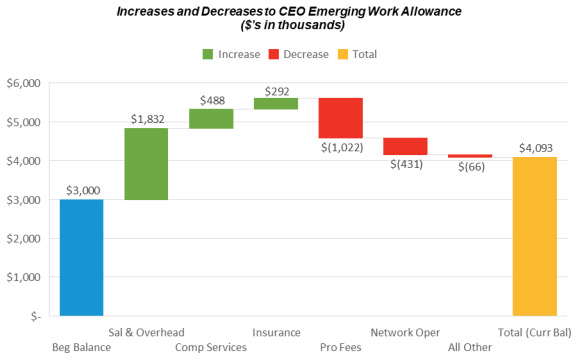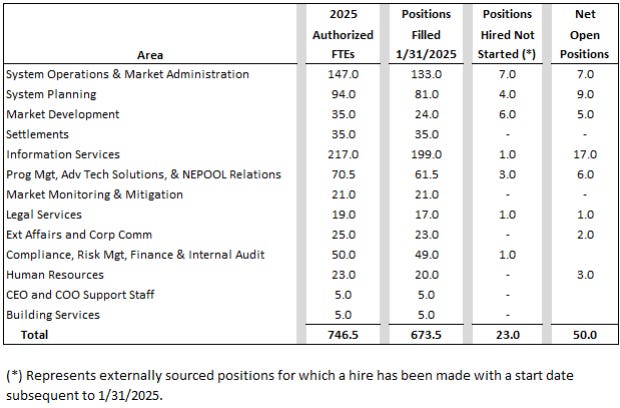BONUS: ISO-NE is Still Terrifyingly Understaffed
talent is oxygen and the transmission operator of new england is asphyxiating god help us
hi here’s a quick update for a particular klaxon that i think more people should care about
One of my earliest posts for Energy Crystals was an alarm bell on staffing challenges in the Independent System Operator of New England (ISO-NE), with the subtitle “I promise it’s worse than you think.”1
Talent is Oxygen, and We’re All Short of Breath
ISO New England (ISO-NE), the keeper of electricity markets in New England, has been running an ancillary market initiative called the Inventoried Energy Program. This program exists because in the winter, New England needs six five billion cubic feet per day of natural gas but has the pipeline capacity for…
In it, I laser in on ISO-NE’s debilitating staffing shortage as it embarks on some pretty serious market reforms, including but not limited to a complete overhaul of its capacity market. We will get to the Capacity Auction Reforms.
ISO-NE has just released their January 2025 financial results, and their staffing problem has not improved. The topline clickbait headline is that ISO-NE’s January 2025 revenues were 4.1% above expectation, simply because load volumes were higher than expected. That’s not quite a red flag for ISO-NE’s load forecasting accuracy,2 but it is a yellow flag.
More pressing to me are the changes in the “CEO Emerging Work Allowance.” This is a pool of money budgeted for unplanned labor expenses—over-budget projects, sudden consultant fees, updated accounting estimates. Notably, any labor underspend (real or projected) pools into this Emerging Work Allowance. It started this year at $3.0M flat. As of the end of January 2025, it’s $4.1M.
What?
The report attributes this mostly to a decrease in Salaries & Overheads by $1.8M (-1.1% of budget), which is offset by an increase in Professional Fees & Consulting by $1.0M (+4.1% of budget).3 About three-quarters of that decrease in salary spend is because new staff simply are paid less and given smaller merit raises than the outgoing staff they replaced. Chillingly, 7% of that decrease is because of the intern program. Either interns didn’t show up (bad), or someone cut that budget (worse). By contrast, the consulting budget ticked up primarily because of IT and software upgrades relevant to analysis ISO-NE must do for the Capacity Auction Reforms project.
I don’t want to overstate this issue. These are single-digit deviations, and it looks like these budget adjustments are based on projections out to year-end 2025. But $1.8M comes out to around 10-ish mid-career FTEs under budget.4 And helpfully, ISO-NE gives a chart of their staffing challenges:
As of 31 January 2025:
Systems Operation & Market Administration was 90% staffed.
System Planning was 86% staffed.
Market Development was 69% staffed.5
Information Services was 92% staffed.
Program Management, Advanced Technical Solutions, & NEPOOL Relations was 87% staffed.6
Human Resources was 87% staffed.
Taken as a whole, ISO-NE is missing 10% of the staff they think they need. There are 73 empty desks in ISO-NE, of which only a third have been “filled” with an offer letter and six months of onboarding before the new hires get clearance for Big Red Buttons. Their “Open Positions” page offers 33 open job descriptions.
The best-case scenario suggests that ISO-NE’s $1.8M staff underspend is projected over a year, meaning that they expect to struggle through 2025 with ten-ish empty desks as a year-end average as they fill desks. At worst, the fact that such a projection has emerged one month into the budget period suggests that we may see that underspend widen to $2.5M once February 2025 financial results emerge.
How can you be surprised that the Day-Ahead Ancillary Services rollout was a buggy mess, when the IT staff is missing seventeen people?
How can you expect the Capacity Auction Reform program to run on schedule when the relevant team is understaffed by a third?
How can you be surprised that ISO-NE is slow to respond to stakeholders when that team needs ten more people to unclog the phone lines?
And how effectively can ISO-NE dig out of this hole when they’re down two go-fer staff in their HR department?7
This isn’t something I can fix. I’m not an HR expert, and plugging a staffing hole at ISO-NE would leave a bigger hole at my current job. I guess someone could circulate my post on hiring underqualified Zoomers through their office, but the best time to do that would have been three years ago, before they needed to rearchitect their reserve market and their capacity market and their financial assurances policy.
This is simply a bear signal: expect things to get worse. Heck, expect brownouts, because the organization trying hardest to prevent that is missing 10% of their staff. And—speaking from experience—ballooning scope and persistent understaffing motivates attrition.
In December, I promised the talent situation was worse than you think. I’m now realizing it’s worse than I thought, too.
This post and the information presented are intended for informational purposes only. The views expressed herein are the author’s alone and do not reflect those of their current or previous employers or any elected officials. The author makes no recommendations toward any electric utility, regulatory body, or other organization. While certain information contained herein has been obtained from sources believed to be reliable, the author has not independently verified this information, and its accuracy and completeness cannot be guaranteed. Accordingly, no representation or warranty, express or implied, is made as to, and no reliance should be placed on, the fairness, accuracy, timeliness or completeness of this information. The author assumes no liability for this information and no obligation to update the information or analysis contained herein in the future.
Shoutout to
at ChinaTalk for linking to that piece in a very important piece on transformers that you absolutely should read:A 5% variance would worry me.
There were movements in other line items, which is why the topline math doesn’t match up. I’m an engineer, not an accountant.
By “mid-level FTE,” I mean someone with a relevant Master’s degree getting paid $90-120k in salary, plus benefits, taxes, and overhead. Effectively, me plus three years.
This, in fact, is not nice.
That 0.5 FTE line item suggests someone who wants to retire but is kept around because they’re too necessary to do without. But that’s mere conjecture.
As of 28 March 2025, ISO-NE has two open job descriptions relevant to HR: “Receptionist / HR Assistant” (entry-level, day-to-day tactical work, managing calendars and inboxes) and one “Human Resources Business Partner” (mid-level, operation-level HR work, implementing organizational changes). The financial statement says ISO-NE has three empty seats in HR, and I seriously doubt (Highly Improbable 5-20%) that ISO-NE needs two HR Business Partners right now.






“Master’s degree getting paid $90-120k in salary,” This explains it all to me honestly. Insultingly low salary for the difficulty of the work required and the degrees required. Anybody smart enough to do high energy work is smart enough to become a web dev and get paid twice as much for less effort. The people there need to wake up and realize that they need to double their salary bill to have any hope of fixing things, but I suspect that they’ll do anything other than that. It’s better to spend millions on projects nobody can execute ya know.